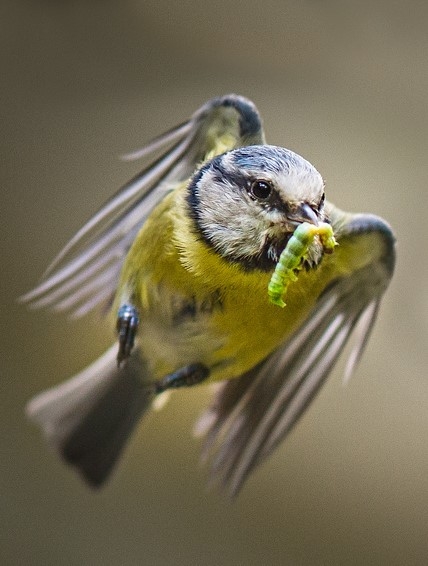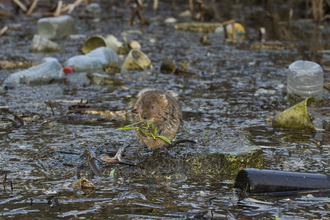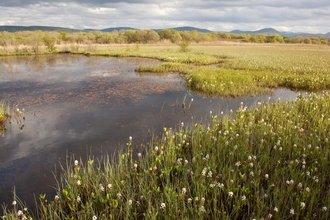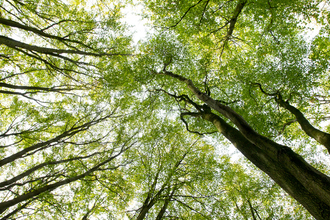
(c)Stephen Barlow
The Climate and Ecological Emergency
Climate change, brought about through human activities, threatens our world. Destruction of forests, moorland, peatbogs and other natural habitats reduces the earth’s ability to absorb carbon from the atmosphere, while also causing devastating damage to wildlife and an ecological emergency.
We cannot solve one crisis without tackling the other – nature’s recovery is vital for tackling climate change.
What is climate change?
Climate change is the catch-all term for the shift in worldwide weather phenomena associated with an increase in global average temperatures. There is now clear evidence that human activities are contributing to rapidly increasing climate change.
Reliable temperature records began in 1850 and our world is now about one degree celcius hotter than it was in the period between 1850 and 1900 – commonly referred to as the "pre-industrial" average. The change is even more visible over a shorter time period – compared to average temperatures between 1961 and 1990, 2017 was 0.68 degrees warmer, while 2016 was 0.8 degrees warmer.
While this temperature increase is more specifically referred to as global heating, the climate crisis is the term currently favoured by science communicators, as it explicitly includes not only Earth's increasing global average temperature, but also the climate effects caused by this increase.
Global efforts are now focused on keeping temperatures from increasing more than two degrees above that pre-industrial average, and ideally no more than 1.5 degrees. That goal may still be possible if the international community pulls together.
Will climate change impact us in Shropshire?

Blue tit with caterpillar by Gillian Lloyd
Climate change is already affecting us. Increasing occurrence of extreme weather, such as torrential rain and long spells of drought bring disruption to our lives. Our ability to grow food depends on stable climates and seasons. Increasingly wet summers and warmer winters make land conditions unfavourable to many food types that farmers grow. As demand increases, food prices will increase, so we are likely to feel the impact of climate change on our wallets as well as in the availability of a diverse array of food.
There are deep concerns about the effects on wildlife too. For example, the leafing date of the oak tree determines when caterpillars will appear, and that determines when certain insectivorous birds - such as blue tits - lay their first egg. Climate change is causing a shift in the times at which trees come into leaf and when insects lay their eggs. If the dates no longer correspond, there will be fewer insects for birds to feed to their young.
Dormice brought out of hibernation by warmer winters are unable to find food and a raised water temperature can affect the ability of fish, such as salmon, to breed in the River Severn.
What are we doing?
Shropshire Wildlife Trust manages over 40 nature reserves which store approximately 90,000 tonnes of carbon! These sites often have an undamaged soil and higher species diversity that other areas. The effects of climate change may change the species composition of these sites but their underlying value as protected 'reservoirs' of wildlife will not diminish and they will remain important sources of biodiversity.
Shropshire Wildlife Trusts' Climate Change Motion
At our AGM in October 2019, Shropshire Wildlife Trust members agreed the following 6 point plan to help tackle the climate crisis. We will:
1. Declare a climate emergency and biodiversity crisis. Our target is zero carbon by 2030 in relation to the CO2 emissions from fossil fuels in our activities and operations including energy purchases.
2. Ensure that any financial investments divest from companies with fossil fuel interests. This includes the pension scheme for SWT staff.
3. Comprehensively use and vigorously promote biodiversity net gain in all our advice and policies except where irreplaceable habitats are involved such as ancient woods, veteran trees, fens and bogs.
4. Provide sound advice about adaptation for the increasing effects of the rapidly changing climate. Resilient ecological networks are needed where habitats are joined up by green and blue corridors. These need to be extended for species to colonise new areas. Our mantra is ‘More, Bigger, Better, and Joined-up habitats’.
5. Create clear narratives to explain why dealing with both the climate emergency and the biodiversity crisis is critical to our future. Shropshire Wildlife magazine will contain regular articles about the climate emergency and the biodiversity crisis.
6. Report on progress to the AGM and to the Members’ Forum in future years.
Shropshire Climate Action Partnership
Shropshire Climate Action Partnership is being established to coordinate a collaborative Shropshire-wide community response to the climate and ecological crisis and oversee the creation of a Zero Carbon Shropshire Plan (ZCSP) that provides an adequate response to the emergency.
Shropshire Wildlife Trust sits on the steering group for SCAP, you can find more here.
SCAP has developed and published Version 1 of the Zero Carbon Shropshire Plan. This plan captures the ongoing ‘work in progress’ being undertaken through working groups on; land and biodiversity, energy, buildings, transport, consumption and resources, carbon tracking and reporting and community engagement.
This Version 1 therefore represents the basis for further consultation, feedback and refinement, and we are planning to publish Version 2 by August 2021.
If you are your business/employers would like to support SCAP, then you can find out how to get involved via their website.
The Wildlife Trusts
For decades, Wildlife Trusts up and down the country have been working on the ground to restore nature. We protect and recover important habitats that lock carbon safely away and limit the effects of climate change,
In response to the climate crisis, The Wildlife Trusts will:
- Step up our work to restore vital habitats and natural climate solutions on a landscape scale.
- Call for natural climate solutions and nature’s recovery to be the priority in tackling climate change, such as plans to achieve net zero.
- Continue to push for the creation of a national Nature Recovery Network to restore thriving ecosystems and give wildlife space to adapt.
- Ensure natural solutions are at the heart of local and national decision-making, such as planning, and work to protect them from damaging development and infrastructure projects.
- Work to ensure people of all walks of life can connect with and enjoy nature, for the benefit of our health and wellbeing.

Round leaved sundew {Drosera rotundifolia} (c) Ross Hoddinott/2020VISION
Nature Based Solutions
Nature Based Solutions come in many forms, from protecting or restoring existing ecosystems to innovative approaches and new projects that protect or enhance the natural environment.
Thriving habitats can safely lock up vast amounts of carbon, while providing other vital benefits that help us adapt, such as flood prevention, clean water and improved health and wellbeing. They also provide a place for nature to recover.
We are involved in several projects and initiatives.

Sheepleas chalk meadow - James Adler
Nature Recovery Networks
A Nature Recovery Network will connect nature-rich places, everywhere, bringing wildlife and the benefits of a healthy natural world into every part of life.
This approach has been the guiding principle of our work for many years.
Find out more about Nature Recovery Networks and the projects we are involved with to make this happen.
Latest news

New poll finds most people think main parties falter on nature and climate crises in the run up to General Election
Shropshire Wildlife Trust urges all parties to heed voter concern and pledge bold action on the twin emergencies

New Wildlife Trusts’ COP26 report released
Climate action needs nature. Nature needs climate action. Neither will succeed if we don’t prepare for a changing world

Government plans for nature and net zero announced today
Seeds of hope planted but root and branch change on mammoth scale still needed, say The Wildlife Trusts.

